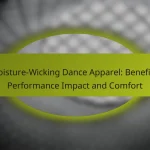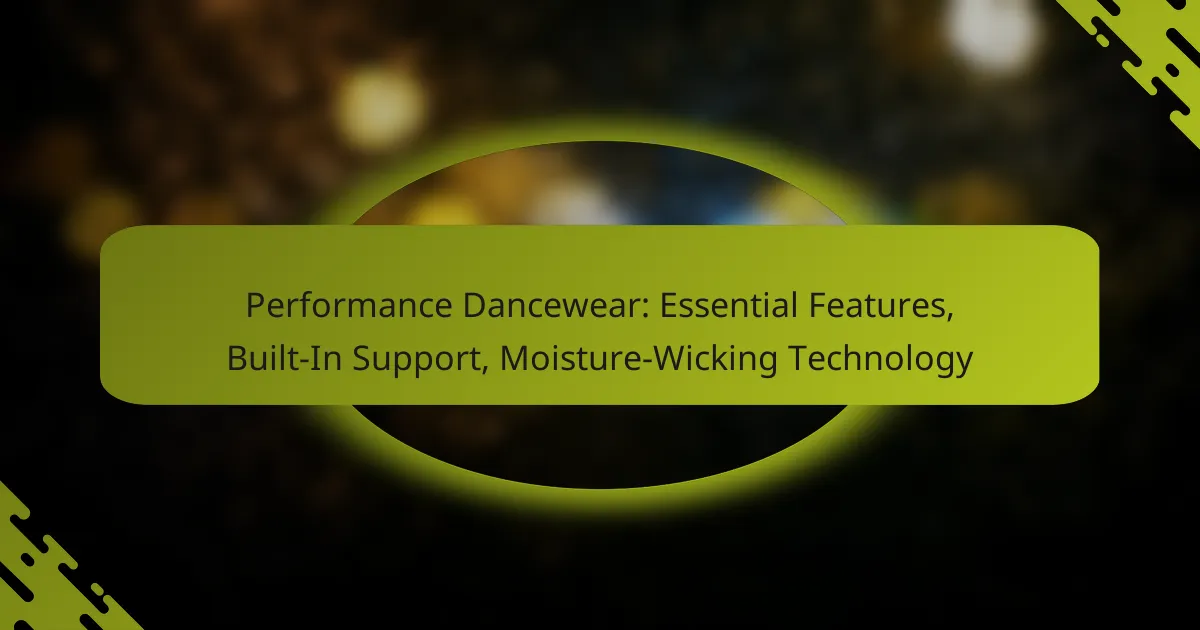Dancewear plays a crucial role in enhancing a dancer’s performance by providing the necessary support, comfort, and flexibility. Well-designed attire, made from moisture-wicking and breathable materials, allows for precise movements while ensuring that dancers can express themselves fully. Styles that incorporate stretchable fabrics enable a wide range of motion, making it easier to execute complex choreography with grace and ease.

How does dancewear impact performance in ballet?
Dancewear significantly influences performance in ballet by enhancing movement, providing support, and ensuring comfort. Properly designed attire allows dancers to execute their movements with precision and grace, which is essential for achieving optimal performance.
Enhanced movement efficiency
Efficient movement is critical in ballet, and the right dancewear facilitates this by reducing drag and allowing for a full range of motion. Fabrics that are lightweight and stretchy, such as spandex blends, enable dancers to move freely without restriction. This efficiency can lead to improved execution of complex choreography.
Choosing dancewear that fits well is essential; overly loose or tight clothing can hinder performance. Dancers should look for garments that contour to the body while still allowing for flexibility, ensuring that every movement is as fluid as possible.
Improved body alignment
Proper body alignment is crucial for preventing injuries and achieving the aesthetic qualities of ballet. Dancewear designed with supportive features, such as built-in bodices or structured seams, helps dancers maintain correct posture and alignment during performances. This support can be particularly beneficial during long rehearsals or performances.
Additionally, wearing the right dancewear can serve as a visual cue for dancers, reminding them to engage their core and align their bodies correctly. This can enhance their overall technique and contribute to a more polished performance.
Support for jumps and turns
Jumps and turns are fundamental elements of ballet that require both strength and support from dancewear. Attire that includes reinforced areas, such as a supportive waistband or padded sections, can help absorb impact and provide stability during these dynamic movements. This support is essential for maintaining control and balance.
Dancers should consider the type of fabric used in their dancewear; materials that offer compression can enhance muscle support and reduce fatigue during intense routines. Investing in high-quality dancewear can make a noticeable difference in performance, especially during demanding sequences that involve multiple jumps and turns.

What features contribute to comfort in dancewear?
Comfort in dancewear is primarily influenced by the choice of materials and construction techniques. Key features such as moisture-wicking fabrics, seamless construction, and breathable materials play a significant role in enhancing a dancer’s performance and overall experience.
Moisture-wicking fabrics
Moisture-wicking fabrics are designed to pull sweat away from the skin, keeping dancers dry and comfortable during practice or performances. These materials often include synthetic fibers like polyester or nylon, which can effectively manage perspiration.
When selecting dancewear, look for labels that specify moisture-wicking properties. This feature is particularly beneficial in high-intensity dance styles, where sweat production is significant. Brands may use terms like “quick-dry” or “performance fabric” to indicate these capabilities.
Seamless construction
Seamless construction minimizes the number of seams in dancewear, reducing friction and irritation against the skin. This design enhances comfort, allowing for a greater range of motion without the distraction of chafing.
When choosing seamless options, consider how they fit your body type and movement style. While seamless garments can provide a sleek look, ensure they also offer adequate support and flexibility for your specific dance discipline.
Breathable materials
Breathable materials allow air circulation, helping to regulate body temperature during physical activity. Fabrics such as cotton blends or mesh panels are commonly used in dancewear to enhance ventilation.
Prioritize breathable options, especially for warm environments or lengthy rehearsals. Look for dancewear that combines breathability with other features like moisture-wicking to maximize comfort and performance.

Which dancewear styles offer the best flexibility?
Dancewear styles that provide the best flexibility typically include stretchable leggings, leotards with spandex, and wrap skirts. These garments are designed to move with the body, allowing dancers to perform a wide range of movements without restriction.
Stretchable leggings
Stretchable leggings are a popular choice for dancers due to their ability to conform to the body’s shape while allowing for extensive movement. Look for leggings made from materials like nylon or polyester blended with elastane, which provide both comfort and stretch.
When selecting leggings, consider the thickness and opacity. Thicker leggings may offer better support, while lighter options can enhance breathability. Aim for a fit that is snug but not constricting to maximize flexibility.
Leotards with spandex
Leotards made with spandex are essential for dancers seeking maximum flexibility. The inclusion of spandex allows these garments to stretch in multiple directions, accommodating various dance styles and movements.
When choosing a leotard, pay attention to the cut and design. Styles with higher necklines or full backs provide more coverage, while lower cuts can enhance freedom of movement. Ensure the leotard fits well to avoid any distractions during performances.
Wrap skirts for ease of movement
Wrap skirts are an excellent addition to any dancer’s wardrobe, offering both style and practicality. These skirts can be easily adjusted to fit comfortably around the waist, allowing for a customized fit that enhances movement.
When selecting a wrap skirt, consider the fabric and length. Lightweight materials like chiffon or georgette allow for fluid motion, while longer skirts may provide a more dramatic effect. Ensure the skirt allows for full range of motion without getting in the way during dance routines.

What are the key attributes of high-quality dancewear?
High-quality dancewear is characterized by its durability, fit, and aesthetic appeal, all of which significantly impact a dancer’s performance. Selecting the right dancewear can enhance comfort and flexibility, allowing for better movement and expression during performances.
Durability and wear resistance
Durability in dancewear ensures that garments can withstand the rigors of frequent use and washing. Look for materials like nylon or spandex blends that offer both stretch and strength, as they tend to hold up better over time compared to cotton. A good quality piece should maintain its shape and color after multiple washes.
When shopping, check for reinforced seams and quality stitching, as these features contribute to the longevity of the garment. Investing in durable dancewear can save money in the long run, as it reduces the need for frequent replacements.
Fit and sizing accuracy
Fit is crucial in dancewear, as it directly affects a dancer’s movement and comfort. Properly fitting dancewear should allow for a full range of motion without being too loose or restrictive. It’s advisable to refer to sizing charts provided by manufacturers, as sizes can vary significantly between brands.
Consider trying on different styles to find what works best for your body type. Pay attention to how the fabric feels against your skin and whether it stays in place during movement. A well-fitted garment can enhance performance and boost confidence on stage.
Design and aesthetic appeal
The design of dancewear plays a significant role in how dancers express themselves. High-quality dancewear often features stylish cuts, colors, and patterns that can enhance a dancer’s overall look. Choose designs that not only appeal to your personal taste but also complement your dance style.
Additionally, consider the context of your performances. For example, classical ballet may call for more traditional styles, while contemporary dance might allow for more innovative and bold designs. Aesthetic appeal can boost morale and create a strong visual impact during performances.

How to choose the right dancewear for different dance styles?
Selecting the right dancewear is essential for optimal performance, comfort, and flexibility across various dance styles. Consider the specific requirements of each style, including the fit, material, and design, to enhance your movement and expression.
Ballet-specific leotards
Ballet-specific leotards are designed to provide support and allow for a full range of motion. They typically feature a snug fit, often made from stretchy materials like cotton or spandex, which helps dancers maintain proper alignment and posture.
When choosing a leotard, consider the neckline and sleeve style that best suits your body type and personal preference. Classic options include tank, short sleeve, or long sleeve designs. Additionally, look for leotards with built-in bras for added support during rigorous practice sessions.
Contemporary dance leggings
Contemporary dance leggings offer flexibility and comfort, allowing for a wide range of movement. They are often made from breathable, moisture-wicking fabrics that keep dancers cool and dry during performances and rehearsals.
When selecting leggings, opt for styles that provide a good fit without being restrictive. High-waisted options can offer extra support and coverage, while cropped lengths may enhance mobility. Consider layering with a loose-fitting top to create a balanced look that allows for freedom of movement.










